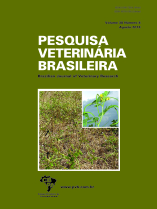 |
|
|
|
Year 2018 - Volume 38, Number 8
|

|
Characterization of parasitic lesions of sheep observed at slaughter line, 38(8):1491-1504
|
ABSTRACT.- Panziera W., Vielmo A., De Lorenzo C., Heck L.C., Pavarini S.P., Sonne L., Soares J.F. & Driemeier D. 2018. [Characterization of parasitic lesions of sheep observed at slaughter line.] Caracterização das lesões parasitárias de ovinos observadas na linha de abate. Pesquisa Veterinária Brasileira 38(8):1491-1504. Setor de Patologia Veterinária, Faculdade de Veterinária, Universidade Federal do Rio Grande do Sul, Av. Bento Gonçalves 9090, prédio 42505, Porto Alegre, RS 91540-000, Brazil. E-mail: davetpat@ufrgs.br
Considering the possibilities of mistaken diagnoses in identifying lesions at meat inspection this study was designed to provide data for a better-educated diagnosis by the meat inspectors through the gross and microscopic characterization of parasitic lesions observed in slaughtered sheep at the inspection line. One hundred and sixty-one samples of parasitic lesions were sampled from various organs of slaughtered sheep during two visits to a sheep abattoir located in the state of Rio Grande do Sul, Brazil. Lesions observed included hydatid cysts, cysticercosis due to Cysticercus ovis and to Cysticercus tenuicollis, sarcocystosis (morphology compatible with Sarcocystis gigantea), fasciolosis (Fasciola hepatica) and oesophagostomosis. Twenty-five point five percent of the 161 samples corresponded to hydatidosis and the hydatid cysts were observed predominantly in the lungs (46.3%) and liver (41.5%). On cut surface, the cysts had three different morphological patterns: viable unilocular cysts (34%); viable multivesicular cysts (31.7%); and degenerate (unilocular and multivesicular) hydatid cysts (34%). Cysticercosis by C. ovis (22.4%) was observed in the myocardium (63.9%), tongue (13.9%), masseter (11.1%), and diaphragm (11.1%). Morphologically the cysticerci were classified as viable, degenerated or mineralized. Lesions caused by S. Gigantea (19.2%) were observed in the muscle layer of the esophagus, tongue, and larynx. Grossly there were multiple white nodular structures that contained a fibrous capsule with the lumen filled by translucent and gelatinous material. Cysticercosis by C. tenuicollis accounted for 18.6% of observed parasitic lesions; the cysts adhered to the omentum, mesentery, liver capsule, and serosal surface of gall bladder; grossly the cysts were classified as viable and degenerated. Viable cysts had translucent or slightly opaque walls and contained a single scolex. Degenerated cysts were white, firm and with a thick fibrous capsule and mineralized center. Lesions caused by F. hepatica accounted for 7.4% of the cases and were grossly characterized by variable fibrous thickening of bile ducts which occasionally contained the adult flukes in their lumina. In eight cases there were marked areas of necrosis in the hepatic parenchyma. Lesions caused Oesophagostomum spp. accounted for 6.8% of the observed parasitic cases and the changes were observed in all cases in the walls of the small and large intestine; in two cases mesenteric lymph nodes were also involved. In the intestines, lesions were characterized by firm well-circumscribed nodules prominent in the serosal surface and also invading the muscle layer. In the lymph nodes marked mineralization obliterated the nodal parenchyma. The correct identification of the various parasitic lesions found in the viscera of sheep in the abattoir inspection line it is important to dictate the proper destination of affected organs and carcasses. The lesions should be evaluated aiming to determine their infective capacity and to acquire knowledge about their more frequent anatomical sites. |
| |
|
|
| |
|
 |